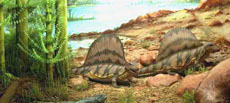 |
 |
 |
 |
 |
Produced
by the Population Genetics and Evolution class, Furman University |
||||
 |
 |
 |
 |
 |
Produced
by the Population Genetics and Evolution class, Furman University |
||||
 |
The
Permian Extinction 'Event' |
 |
||
| Approximately
252.6 my ago, up to 96 percent of marine species and up to 70 percent
of land species became extinct (Sephton et al. 2009). This is the single
largest extinction event in Earth's history, defining the boundary between
the Paleozoic and Mesozoic eras. A great deal of controversy surrounds
this 'event', and a variety of explanations have been proposed. In Siberia,
the largest expanse of basaltic lava on Earth dates from this period and
suggests that volcanic explosions may have caused an 'ecological winter'
that caused food webs to collapse and may have poisoned the atmosphere
(Brayard et al. 2009). Meteorite impacts in China date to this period,
as well, and may have contributed to the collapse of ecosystems. Methane
hydrate discharge, oceanic anoxia, gradual sea fall and climate change
have also been implicated (Geological Society of America 2001). More recently,
the release of halogenated gases by microbial activity in massive salt
lakes has also been proposed (Weissflog et al. 2009). Indeed, all of these
factors, occurring in a short geological period, may have combined to
produce this extraordinary extinction event. Another point of contention
is how long it took for biodiversity to recover. At first, it was believed
to be consistent with estimates for the same process after other extinctions;
that is, 5 to 15 my. However, recent discoveries of large ammonoid fossils
dated to 1 my following the extinction suggests that recovery might have
been much more rapid for some groups (Brayard et al 2009), especially
for marine life (Brayard et al 2010). Page by Will Towler |
 |
| Microbes in salt lakes like this have been implicated in the Permian extinction. Photo from Science Daily | |
| Brayard A, Escarguel G, Bucher H, Monnet C, Brühwiler T, Goudemand N, Galfetti T, Guex J. 2009. Good genes and good luck: ammonoid diversity and the end-Permian mass extinction. Science. 325: 1118. Brayard A, ützel A, Stephen DA, Bylund KG, Jenks J, Bucher H. 2010. Gastropod evidence against the early Triassic Lilliput effect. Geology. 38: 147. Geological Society of America. 2001. Permian extraterrestrial impact caused largest mass extinction on Earth. Science Daily. Accessed March 17, 2010. Sephton MA, Visscher H, Looy CV, Verchovsky AB, Watson JS. 2009. Chemical constitution of a Permian-Triassic disaster species. Geology. 37: 875. |